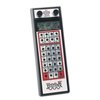Product Support for: Throttles -> Advanced Duplex Radio Equipped Super Throttle (DT500D)
View the Product Page for the DT500DThe DT500D is our top-of-the-line, Duplex Radio Super Throttle. The DT500D Advanced Super Throttle gives you direct control of two locos at a time with all the powerful features and flexibility serious model railroaders demand. The DT500D is designed to handle nearly every aspect of layout control.
6 Articles Found for DT500D
Clarifications of UR93 and DT602D/UT6D Duplex RF and network performance: The new UR93 and DT602D and UT6D throttles employ the new Digitrax designed and manufactured RF28 Modular Certified 2.4GHz transceiver module. The RF28 is configured to interoperate with existing Digitrax Duplex UR92 LocoNet access points and e.g. DT500D and UT4D throttles worldwide. All Duplex units employ IEEE 802.15.4 PHY/MAC compatible devices using 2.4GHz Direct Sequence Spread- Spectrum (DSSS) modulation. The RF28 was developed for: a) Smaller size. The venerable RF24 could not fit in the small UT6D, and this case was designed in 2017, so a new smaller Duplex support ...
Digitrax Query Mode: The new generation of Digitrax Advanced Command Stations and other new products from ~October 2016 onwards include some convenient new self-diagnostic and external diagnostic capabilities and methods, to help keep LocoNet systems and devices healthy and working optimally, without requiring additional tools. The DCS240 and DCS210 Advanced Command Stations include “Query Mode” diagnostic information that can be interrogated or read-out using enhanced capabilities of DT500 throttles. Advanced Command Station Query information is grouped into six broad groups of data/diagnostic information displayable by a DT500/DT500D: “Lnt”: LocoNet Device Type/product info “ELE”: Device Electrical information, voltages/currents, etc. “Lnt”: LocoNet ...
Setting Duplex Group Name You can use the DT402D to edit the UR92’s Duplex Group name to one you prefer. Note that this change is optional, and the UR92 factory default will always work out of the box. The Duplex Group Name is stored in non-volatile memory and is remembered even when unpowered or disconnected from your system. You should have all UR92s connected prior to changing the Group name or they will automatically renegotiate and may change the preferred name to a default. 1. Connect the DT402D or DT500D to the front RJ12 jack of any UR92 ...
Configuring the Duplex Group Password The UR92 ships from the factory with the default Duplex Group Password of 0000, the value that disables password requirements. You may have an occasion when operating in a multisystem environment when you may want to restrict access to your layout and operating system via a tetherless Duplex Throttle. The password for your Duplex Group may be activated or changed: 1. Plug a DT402D or DT500D throttle into the UR92. 2. Press the EXIT key. 3. Press the OPTN key then the EDIT key. 4. Enter a 4-digit number using the numbers on the keypad ...
The following chart indicates: Which Digitrax throttle (DT400, DT400R, DT402, DT402R, DT402D, DT500, DT500D, DT602, DT602D, UT4, UT4R, UT4D, UT6 & UT6D) Works with which LocoNet interface throttle panel (Universal Panel-UP3/UP5/UP7, UR90, UR91, UR92, and UR93) Under which types of communication (Tethered, IR Mode, Simplex Radio, or Duplex Radio). Throttle Interface Chart Throttle UP Panel Tethered UR90 Tethered UR90 IR Mode UR91 Tethered UR91 IR Mode UR91 Simplex Radio UR92 Tethered UR92 IR Mode UR92 Duplex Radio UR93 Duplex Radio DT400 Yes Yes Yes Yes Yes No Yes Yes No No DT400R Yes Yes Yes Yes Yes Yes Yes Yes ...
Digitrax Complete Train Control By Zana & A.J. Ireland Digitrax Complete Train Control makes reliable, realistic train operation and simplified layout wiring a reality. Digital Command Control is incorporated within the Digitrax system to let you control multiple trains independently on the same section of track without blocking. In the real world, engineers control the speed and direction of real trains. Engines operate under their own power independent of the track. Each engine has its own motion characteristics like how fast it speeds up (acceleration) and how long it takes to slow down (deceleration). A locomotive's performance is influenced by ...
